Understanding Harmonics—Part 1
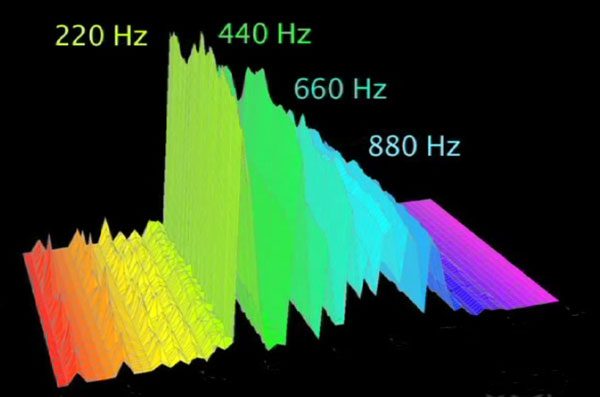
This article was written by Dr. John Holcombe
How many of us pipers have a firm grasp of the physics of sound that causes the unique and rich sound of our bagpipes? We are told that we should maintain a pressure in the pipe bag that is at the chanter reed’s “sweet spot”, that pressure that causes the reed to maximally vibrate and bring out the most “harmonics” and richness of sound of the reed. But what, really, are harmonics?
Much of the information contained in this article is from a fascinating series of lectures by Scott Laird, music instructor at the North Carolina School of Science and Math, in which he discusses the intersection of music and science. But before we can discuss the complex harmonics produced by a bagpipe, it is best to understand some basics of sound and how it is described.
Sound is defined as the sensation produced by stimulation of certain organs in our inner ear brought about by vibrations transmitted through the air or other medium, such as water or a solid from a vibrating object, such as a string, vocal cords, or a bagpipe chanter or drone reed. The vibration of the object disturbs the air immediately around it and creates pressure waves that travel through the air, finally reaching our ears. Sound in its most basic form can be represented by what is called sine waves, see Figure 1.
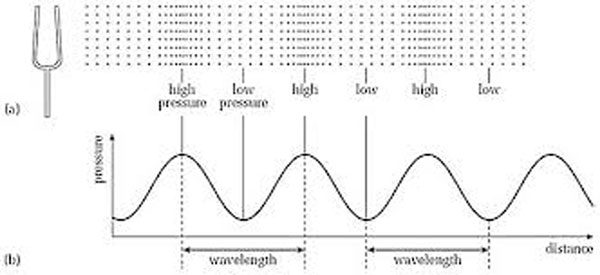
In this example, a vibrating tuning fork causes the air around it to become disturbed, with areas of increased compression (higher pressure) followed by an area of lower pressure. These disturbances are propagated through the air, much like the waves generated outwardly when a pebble is tossed into still water. The sound waves travel to the ear, where the waves set up similar vibrations of the eardrum. From the eardrum, the waves are converted into electrical signals and sent to the brain, where the waves are interpreted as sound. The closer the waves are to each other, the greater the “pitch” of the sound, and the further the waves are apart, the lower the pitch. The number of waves passing by a given point in one second is defined as Hertz, abbreviated as Hz. Thus, middle C on a piano vibrates at a rate of 256 times per second, or 256 Hz. "Concert A" vibrates at 440 Hz. The height of the waves represents the loudness, or amplitude, of a sound.
As simple as this diagram of a sine wave may appear, it should be pointed out that there are no pure sounds found in nature. Instead, pure tones or sounds are synthesized by a computerized tone generator. Musical instruments, on the other hand, produce very complex sound waves. Figure 2 compares the wave forms between a cello (top image) with that of a tone generator (bottom image), while both are sounding the note “A”, 220 Hz. The cello clearly produces more intricate wave forms, with many more angles and changes than a simple sine wave. However, the similarities between the two graphs in overall shape of the curves remains apparent because the most important pitch being played, “A”, is vibrating at 220 Hz in both examples. Notice how the complex waves still line up with the simpler sine waves.

It is far more interesting, however, to examine sound waves in three dimensions, where the red hue represents lower pitches and the blue and violet represent higher pitches. Figure 3 is a 3D image of a tone generator producing the note “A”, 220 Hz. Notice how clean and undisturbed is the area to the right of the peak sound.
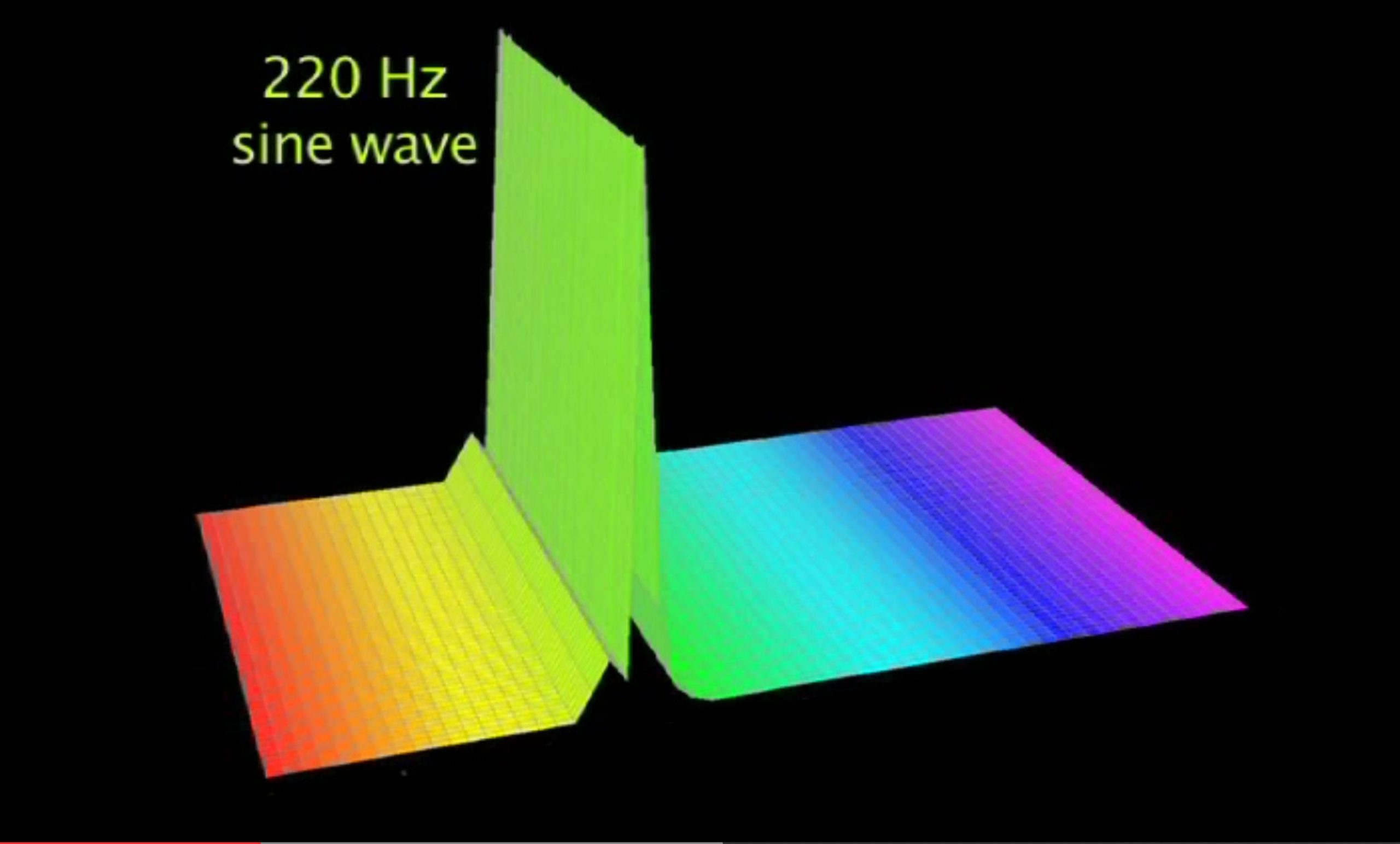
In contrast, Figure 4 is a 3D image of a cello playing the same note “A” 220 Hz.
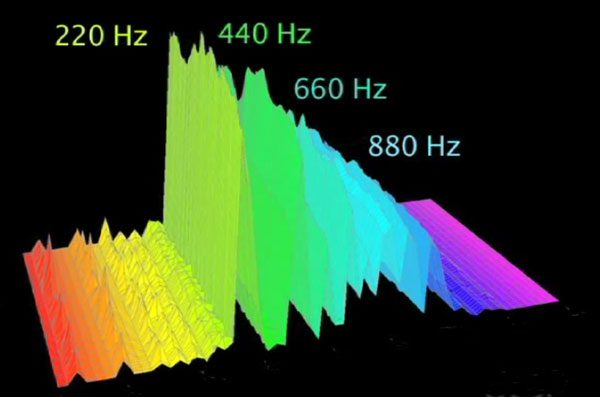
Notice how much more complex the wave patterns are with the cello compared with that of a pure tone. In this example, the cello's loudest frequency is at 220Hz, but a variety of additional waves of lower amplitude but higher pitches are shown to the right of the highest peak. The highest peak is called the “fundamental” pitch, while all the other frequencies are known as “harmonics”. Taken together, the fundamental and all of the harmonics of a particular musical note are known as “timbre”. Timbre is that unique quality of sound that separates all musical instruments from each other. Even human voices have unique timbres, with male voices different from females, even when singing a note of the same pitch. Notice in Figure 4 that the harmonics of the pitch 220 Hz are actually multiples of 220 Hz. In other words, the “fundamental” frequency is 220 Hz, but the next frequency (or first harmonic) is 440 Hz (2 x 220), the second harmonic is vibrating at 660 Hz (3 x 220), and the third harmonic has a pitch of 880 Hz (220 x 4).
In Figure 5, the timbre of a cello is compared with that of a trombone, both sounding "A", 220 Hz. Notice the similarities and differences in timbre between the two images. The cello's fundamental is at 220 Hz, furthest to the left in the image, while the fundamental note of the trombone is of higher pitch and further to the right.
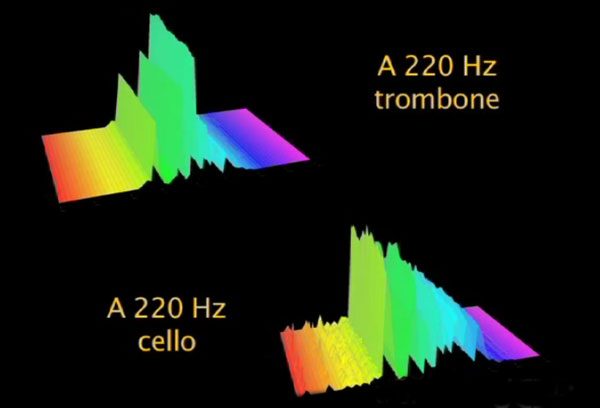
This post has hopefully shed some light on our understanding of why musical sounds are so rich, beautiful, and full of harmonics that blend together to create amazing sounds. In the next article we will explore the relationships between the fundamental and the different harmonics and how they relate to each other in a major scale of music.






I just discovered this post going down rabbit holes in the site. Wow! Thankyou for this visual. Amazing.